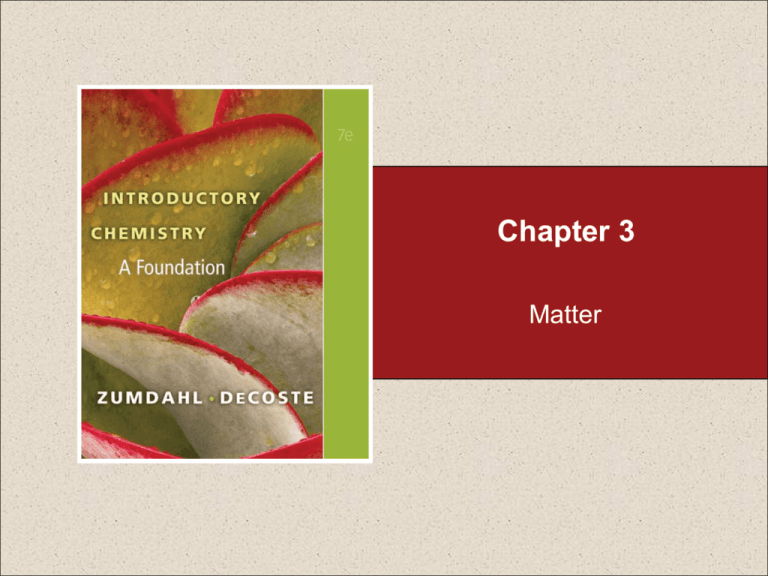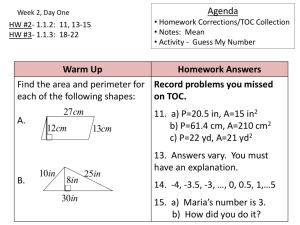
Chapter 3
Matter
Section 3.1
Matter
Matter
•
Anything occupying space and having mass.
•
Matter exists in three states.
Return to TOC
Copyright © Cengage Learning. All rights reserved
Section 3.1
Matter
The Three States of Water
Return to TOC
Copyright © Cengage Learning. All rights reserved
Section 3.2
Physical and Chemical Properties and Changes
Physical Properties
•
•
The characteristics of matter that can be
changed without changing its composition.
Characteristics that are directly observable.
Return to TOC
Copyright © Cengage Learning. All rights reserved
Section 3.2
Physical and Chemical Properties and Changes
Chemical Properties
•
•
A substance’s ability to form new substances.
The characteristics that determine how the
composition of matter changes as a result of
contact with other matter or the influence of
energy.
Return to TOC
Copyright © Cengage Learning. All rights reserved
Section 3.2
Physical and Chemical Properties and Changes
Physical Change
•
Change in the form of a substance, not in its
chemical composition.
Return to TOC
Copyright © Cengage Learning. All rights reserved
Section 3.2
Physical and Chemical Properties and Changes
Three States of Water
Return to TOC
Copyright © Cengage Learning. All rights reserved
Section 3.2
Physical and Chemical Properties and Changes
Chemical Change
•
A given substance becomes a new substance
or substances with different properties and
different composition.
Return to TOC
Copyright © Cengage Learning. All rights reserved
Section 3.2
Physical and Chemical Properties and Changes
Electrolysis of Water
Return to TOC
Copyright © Cengage Learning. All rights reserved
Section 3.2
Physical and Chemical Properties and Changes
Electrolysis of Water
•
Water decomposes to hydrogen and oxygen
gases.
Return to TOC
Copyright © Cengage Learning. All rights reserved
Section 3.2
Physical and Chemical Properties and Changes
Concept Check
How many of the following are examples of a
chemical change?
Pulverizing (crushing) rock salt
Burning of wood
Dissolving of sugar in water
Melting a popsicle on a warm summer day
Return to TOC
Copyright © Cengage Learning. All rights reserved
Section 3.2
Physical and Chemical Properties and Changes
1. Classify each of the following as a physical or chemical
property.
a. Ethyl alcohol boils at 78oC
b. Sugar ferments to form ethyl alcohol
c. Salt is stable at room temperature, it does not
decompose
d. 36 g of salt will dissolve in 100 g of water
2. Classify each of the following as a physical or chemical
change.
a. Sugar fermenting to form ethyl alcohol
b. Dissolving of sugar in water
c. Iron metal melting
d. Iron combining with oxygen to form rust
Return to TOC
Copyright © Cengage Learning. All rights reserved
Section 3.3
Elements and Compounds
Element
•
A substance that cannot be broken down into
other substances by chemical methods.
Return to TOC
Copyright © Cengage Learning. All rights reserved
Section 3.3
Elements and Compounds
Compound
•
A substance composed of a given combination
of elements that can be broken down into those
elements by chemical methods.
Return to TOC
Copyright © Cengage Learning. All rights reserved
Section 3.4
Mixtures and Pure Substances
Pure Substances
•
•
Always have the same composition.
Either elements or compounds.
Return to TOC
Copyright © Cengage Learning. All rights reserved
Section 3.4
Mixtures and Pure Substances
Mixtures
•
•
Have variable composition.
Can be separated into two or more pure
substances: elements and/or compounds.
Return to TOC
Copyright © Cengage Learning. All rights reserved
Section 3.4
Mixtures and Pure Substances
Return to TOC
Copyright © Cengage Learning. All rights reserved
Section 3.4
Mixtures and Pure Substances
Homogeneous Mixture
•
•
•
A solution.
Having visibly indistinguishable parts.
Does not vary in composition from one region
to another.
Return to TOC
Copyright © Cengage Learning. All rights reserved
Section 3.4
Mixtures and Pure Substances
Heterogeneous Mixture
•
•
Having visibly distinguishable parts.
Contains regions that have different properties
from those of other regions.
Return to TOC
Copyright © Cengage Learning. All rights reserved
Section 3.4
Mixtures and Pure Substances
Return to TOC
Copyright © Cengage Learning. All rights reserved
Section 3.4
Mixtures and Pure Substances
Concept Check
Classify each of the following as a pure substance
(compound or element) or mixture (homogeneous or
heterogeneous).
1. Pure water
2. Gasoline
3. Jar of jelly beans
4. Soil
5. Copper metal
Return to TOC
Copyright © Cengage Learning. All rights reserved
Section 3.5
Separation of Mixtures
•
Mixtures can be separated based on different physical
properties of the components.
Different Physical Property
Technique
Boiling point
Distillation
State of matter
(solid/liquid/gas)
Adherence to a surface
Chromatography
Volatility
Evaporation
Filtration
Return to TOC
Copyright © Cengage Learning. All rights reserved
Section 3.5
Separation of Mixtures
Distillation of a Solution Consisting of Salt Dissolved in Water
Return to TOC
Copyright © Cengage Learning. All rights reserved
Section 3.5
Separation of Mixtures
•
No chemical change occurs when salt water is
distilled.
Return to TOC
Copyright © Cengage Learning. All rights reserved
Section 3.5
Separation of Mixtures
Filtration
•
Separates a liquid
from a solid.
Return to TOC
Copyright © Cengage Learning. All rights reserved
Section 3.5
Separation of Mixtures
The Organization of Matter
Return to TOC
Copyright © Cengage Learning. All rights reserved
Section 3.5
Separation of Mixtures
Summary of Topics: Chapter 3
•
•
•
•
•
•
States of matter
Chemical and physical properties and changes
Classification of matter
pure substances (compounds & elements)
mixtures (homogeneous & heterogeneous)
Separation methods
Return to TOC
Copyright © Cengage Learning. All rights reserved






